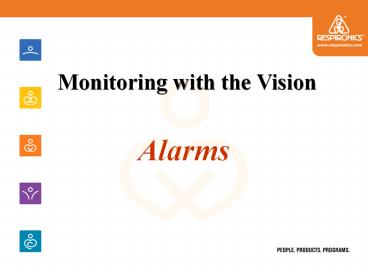Monitoring with the Vision - PowerPoint PPT Presentation
Title:
Monitoring with the Vision
Description:
Monitoring with the Vision Alarms Alarm Overview Alarm: Warning Signal of an Event Event: A Noteworthy Happening An abnormal clinical occurrence Requiring clinical ... – PowerPoint PPT presentation
Number of Views:109
Avg rating:3.0/5.0
Title: Monitoring with the Vision
1
Monitoring with the Vision
- Alarms
2
Alarm Overview
- Alarm Warning Signal of an Event
- Event A Noteworthy Happening
- An abnormal clinical occurrence
- Requiring clinical awareness or action
3
Alarm Overview
- Events Are Related To
- Technical performance of the ventilator system
- or
- Patients clinical condition
4
Alarm Overview
- Two Types of Alarms
- System
- Adjustable
5
Alarm Overview
- Alarm Indications
- Visual
- Audible
- Two Tones
- Alarm Reset
- Manual
- Self-canceling
- Nurse Call/Remote
6
System Alarms
- Check Ventilator Performance
- Preset and Not Adjustable
- Continuous Tone
7
System Alarms
- Ventilator Inoperative
- Check Ventilator
- Pressure Regulation
- Proximal Pressure Line
- O2 Flow
- Exhalation Port
- Disconnect
8
Ventilator Inoperative
System Alarm Audible Visual
- Why?
- System Malfunction
- AC Power Failure
- What Happens?
- Ventilator Powers Down
- Valves Open to Atmosphere
- allows spontaneous breathing
9
Check Ventilator
System Alarm Audible Visual Manual Reset
- Abnormal Operating Condition
- What Happens?
- Ventilator Continues to Operate
- Unit Requires Service
- Visual Indicator Remains Until Condition
Corrected
10
Check Ventilator
System Alarm Visual Audible Manual Reset
- Why?
- Internal Battery Voltage is Low
- What Happens?
- Internal Battery Cannot Sustain Audible Alarm
- AC Power Will Trickle Charge
Error Code 205
11
Pressure Regulation
System Alarm Audible Visual Self-canceling
- Why?
- Proximal and Set Pressure Vary
- /- 5 cm H2O
- What Happens?
- Ventilator Sends Available Flow to Achieve Set
Pressure
P Regulation
12
Proximal Line Disconnect
System Audible Visual Self-canceling
- Why?
- Proximal Pressure lt 1 cmH2O
- What Happens?
- Ventilator Continues to Deliver Set Pressure
ProxLine Disc
13
Oxygen Flow
System Alarm Audible Visual Manual Reset
- Why?
- Insufficient Oxygen Flow
- What Happens?
- FIO2 Cannot be Maintained Ventilator Continues to
Deliver Set Pressure
O2 Flow
14
Exhalation Port
System Alarm Audible Visual Self-Canceling
- Why?
- Baseline Flow Decreases Below Intentional Leak
Rate - 5L/min or 50
- What Happens?
- Ventilator Continues to Deliver Set Pressure
Exh Port
15
Learn Function
- Learns Base Flow
- Upon system start-up
- After mode changes
- Activated manually
- With circuit condition changes
- Modify Alarms screen
16
Disconnect Alarm
System Alarm Audible Visual Self-Canceling
- Why?
- Patient Disconnect
- High flow rates for 4 seconds
What Happens?
Disconnect
- Ventilator decreases flow to idle
17
Flow Limit Control
- What Is It ?
- Recognizes Patient Disconnection
- Decreases total flow to idle
- Flow Returns to Normal
- Spontaneous patient trigger
18
Benefits of System Alarms
- Monitor Operating Specifications
- Warn of Abnormal Operating Conditions
- Visual Messages Facilitate Troubleshooting
19
Adjustable Alarms
- Monitor Specific Patient Parameters
- Clinician Adjustable
- Multiple Tone
20
Adjustable Alarms
- High Pressure
- Low Pressure
- Low Pressure Delay
- Apnea
- Low Rate
- High Rate
- Low Minute Ventilation
21
High Pressure
Adjustable Alarm Audible Visual Self-canceling
- Why?
- Proximal Pressure Exceeds Hi P Alarm Limit
- What Happens? Inspiration is Terminated
- Safety Feature
Hi P
22
Low Pressure Low Pressure Delay
Adjustable Alarm Audible Visual Self-canceling
- Why?
- Proximal Pressure Below Lo P
- Limit for Set Time Delay
- What Happens?
- Ventilator Continues to Function
Lo P
23
Setting Pressure Alarms
- Hi P and Lo P
- Bracket IPAP
- Lo P Delay
- According to patient condition
24
Apnea
Adjustable Alarm Audible Visual Self-canceling
- Why?
- Absence of Spontaneous Trigger for Set Time
Interval - What Happens?
- Timed Breaths are Delivered at Set Rate
Apnea
25
Apnea (cont)
- Audible resets only when condition is corrected
- Two spontaneous triggers
- Safety feature
- Apnea Can be Disabled
26
Low Rate
Adjustable Alarm Audible Visual Self-canceling
- Why?
- Total Respiratory Rate is Below Lo Rate Limit
- Setting Lo Rate Alarm Limits
- Set Below Total Respiratory Rate
- And Above Set Rate
27
High Rate
Adjustable Alarm Audible Visual
Self-canceling
- Why?
- Total Respiratory Rate is Above Hi Rate Limit
- Setting Hi Rate Alarm Limits
- Set Above Total Respiratory Rate
28
Low Minute Ventilation
Adjustable Alarm Audible Visual
Self-canceling
- Why?
- Minute Ventilation Falls Below Set Lo MinVent
Limit - Setting Lo MinVent alarm limits
- Set 20 lt Total Minute Ventilation
- Use MinVent estimation
29
Benefits of Adjustable Alarms
- Monitor Patient Conditions
- Warn of Critical Changes in the Patient
- as determined by the clinician
- Visual Messages Facilitate Troubleshooting































